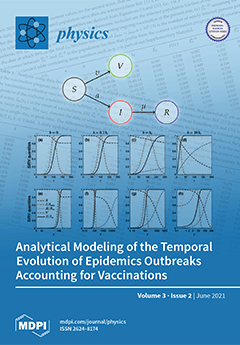With the vaccination against Covid-19 now available, how vaccination campaigns influence the mathematical modeling of epidemics is quantitatively explored. In this paper, the standard susceptible-infectious-recovered/removed (SIR) epidemic model is extended to a fourth compartment, V, of vaccinated persons. This extension involves the time
[...] Read more.
With the vaccination against Covid-19 now available, how vaccination campaigns influence the mathematical modeling of epidemics is quantitatively explored. In this paper, the standard susceptible-infectious-recovered/removed (SIR) epidemic model is extended to a fourth compartment, V, of vaccinated persons. This extension involves the time
t-dependent effective vaccination rate,
, that regulates the relationship between susceptible and vaccinated persons. The rate
competes with the usual infection,
, and recovery,
, rates in determining the time evolution of epidemics. The occurrence of a pandemic outburst with rising rates of new infections requires
, where
and
denote the initial values for the ratios of the three rates, respectively, and
is the initial fraction of infected persons. Exact analytical inverse solutions
for all relevant quantities
of the resulting SIRV model in terms of Lambert functions are derived for the semi-time case with time-independent ratios
k and
b between the recovery and vaccination rates to the infection rate, respectively. These inverse solutions can be approximated with high accuracy, yielding the explicit time-dependences
by inverting the Lambert functions. The values of the three parameters
k,
b and
completely determine the reduced time evolution of the SIRV-quantities
. The influence of vaccinations on the total cumulative number and the maximum rate of new infections in different countries is calculated by comparing with monitored real time Covid-19 data. The reduction in the final cumulative fraction of infected persons and in the maximum daily rate of new infections is quantitatively determined by using the actual pandemic parameters in different countries. Moreover, a new criterion is developed that decides on the occurrence of future Covid-19 waves in these countries. Apart from in Israel, this can happen in all countries considered.
Full article





